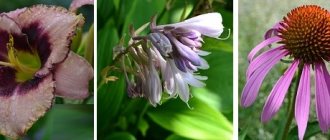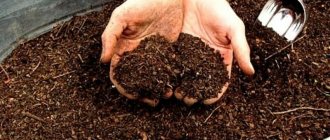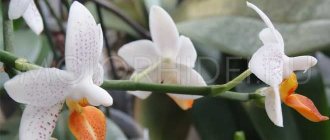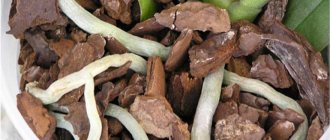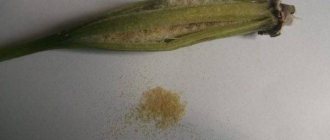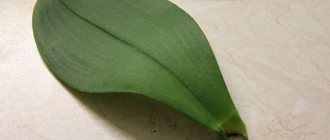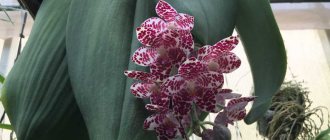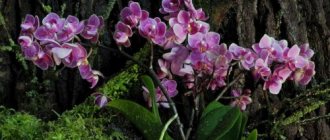Light regime for keeping orchids
It has long been known that the determining factor in the normal functioning of a plant is light. It is this that triggers the processes of photosynthesis and encourages roots to absorb moisture, vessels to direct and redistribute substances in tissues, and the meristem to divide and form new cells.
Illumination is used to assess lighting conditions; it is measured in lux (lx) with special devices - lux meters. During the day and depending on conditions, natural light varies greatly.
For example, on a summer, sunny day in an open place, the illumination is 100,000 lux, at the same time in a room near the south window it is already 50,000 lux, and on the north window it is only 4,000 lux. In summer, in cloudy weather, when the sky is overcast, the illumination in an open area decreases to 1000 lux.
Retreating from the window into the room, natural light falls very quickly. So, if the total illumination outside the window is taken as 100%, at a distance of 0.5 m from the window it will be 50%, at a distance of 1 m - 25%, at a distance of 1.5 m - 10%, and at a distance of 2 m - about 5% .
The illumination is greatly influenced by the orientation of the window to the cardinal points. Plants located on the north window receive approximately 1/10 of the total light level of the south window.
Lighting on the windowsill in winter:
- South window: Sunny - 6000-20000 lux Cloudy - 2000-4000 lux
- East window: Sunny-2500-4000 lux Cloudy-1000-2500 lux
- West window: Sunny - 2000-4000 lux Cloudy - 1000-2000 lux
- North window: Sunny - 1000-2000 lux Cloudy - 300-500 lux
When reading the recommendations on how to keep orchids, try to distinguish between the optimal and minimum levels of illumination. Typically, recommendations give the optimal degree of illumination and characterize it as “low”, “medium” and “high”.
“Low” illumination ranges from 5000-15000 lux, “medium” - 15000-30000 lux, and “high” - 30000 lux and above. Such illumination is typical for species in their natural habitats and, at optimal temperatures, stimulates maximum productivity - good growth of shoots and roots, regular flowering. For example, for phalaenopsis, the optimal illumination is 25,000 lux at a temperature of 23 °C during the day and 18 °C at night.
But when keeping orchids at home, you should focus not on the optimal, but on the minimum illumination, which lasts in our apartments for 6 or more autumn-winter months throughout the year.
At the same temperature, the minimum illumination for phalaenopsis is 7500-11000 lux. The table shows the minimum illumination that orchids need at given temperature conditions.
Table “Minimum illumination and temperature for some genera of orchids”:
| Genus | Min. illumination (lx) | Min. temperature (°C) | |
| Day | Night | ||
| Ada | 2000-7500 | 18-20 | 10-6 |
| Anoectochilus | 2000-5000 | 18-20 | 16-18 |
| Prussia | 2500-7500 | 16-8 | 12-14 |
| Calanlhe | 7500 | 18-22 | 16-18 |
| Cattleya | 2000-7500 | 18-20 | 14-16 |
| Cochlioda | 5000-7500 | 15-16 | 8-10 |
| Coelogyne | 6000 | 8-15 | 6-12 |
| Cymbidium | 2000-7500 | 18-20 | 10-14 |
| Dendrobium | 2000-15000 | 18-22 | 14-18 |
| Epidendrum | 7500 | 18-20 | 16-8 |
| Goodyera | 2000-5000 | 18-20 | 16-18 |
| Ludisia | 2000-5000 | 18-20 | 16-18 |
| Laelia | 5000-10000 | 18-20 | 14-16 |
| Macodes | 2000-5000 | 18-20 | 16-8 |
| Miltonia | 2000-5000 | 18-20 | 14-16 |
| Miltoniopsis | 2000-7500 | 14-16 | 12-14 |
| Odontoglossum | 2000-7500 | 16-18 | 8-14 |
| Oncidium | 2000-7500-10000 | 18-20 | 12-18 |
| Paphiopedilum | 2000-6500-10000 | 16-22 | 12-18 |
| Phaius | 5000 | 18-20 | 14-16 |
| Phalaenopsis | 7500-11000 | 18-22 | 18-20 |
| Phragmipedium | 2500-5000 | 16-20 | 12-14 |
| Pleione | 2500-4000 | 16-20 | 4-11 |
| Vanda | 10000-30000 | 18-20 | 16-18 |
| Zygopetalum | 5000-7500 | 20-25 | 15-18 |
In temperate latitudes during the winter months, the illumination is so low (less than 100 lux in cloudy weather) that on windowsills without artificial lighting, the process of photosynthesis in tropical plants almost completely stops.
In winter, the consumption of plastic substances during respiration (which occurs continuously, both day and night) occurs against the background of low efficiency of photosynthetic reactions, which leads to depletion of the plant.
One-sided room lighting, part of which is delayed and reflected by window glass, a sharp drop in illumination as you move deeper into the apartment from the window, dependence on the orientation of the windows to the cardinal points - all this makes additional lighting necessary for almost all orchids grown in rooms.
Most tropical orchids that live some distance from the equator require slight seasonal changes in the length of the photoperiod. During the “artificial” summer, the length of the day for successful care of orchids while maintaining the house should be at least 14 hours, in winter - 12 hours, and from April the length of the day should again gradually increase to 14 hours.
The exception is the equatorial species, which in their natural habitats grow throughout the year in 12-hour cycles of alternating day and night.
The rhythms of their shoot formation also depend on the hemisphere in which the birthplace of orchids is located, and many residents of the southern hemisphere are forced to produce vegetative growth in the long winter months of temperate latitudes.
They develop “winter” leaves, usually narrower and longer, not adapted to reflect the bright spring sun; as a result, orchids located on a southern window may develop sunburn on the leaves in March-April.
Types of photosynthesis in orchids
Photosynthesis is the process of formation of organic substances from carbon dioxide (CO2) and water (H2O) in light using the pigment chlorophyll, which is found in the chloroplasts of plant cells.
In chloroplasts, carbon dioxide and water, through a complex interaction with chlorophyll, form oxygen (O2) and glucose (C6H12O6), which is then converted into starch, fiber, fats and vitamins, which is the building material for new plant cells and organs.
An orchid, absorbing light energy, converts it into the energy of chemical bonds and accumulates it in the form of organic compounds.
During respiration, the reverse process occurs - the breakdown of complex organic compounds into simpler ones; the accumulated organic matter is consumed, releasing the energy necessary for plants to carry out growth processes and many other vital functions. Breathing occurs both during the day and at night.
Carbon dioxide that enters the plant during photosynthesis and leaves it during respiration uses the same “gates” for passage - stomata, which are located on leaves, stems, peduncles and flowers.
Through these same stomata, plants release oxygen released during photosynthesis, and also absorb and evaporate excess water. The work of stomata, which regulates the influx, transformation and release of carbon dioxide, is directly related to the type of photosynthesis in orchids.
Currently, several types of photosynthesis have been identified in orchids: C3, C4, CAM (Crassulacea Acid Metabolism) and C3-CAM (self-perpetuating photosynthesis).
- During C3 photosynthesis, carbon dioxide enters the plant through open stomata, both during the day and at night.
- During C4 photosynthesis, the stomata are partially covered during the day.
Such photosynthesis is an adaptation of plants to survive drought, high temperatures, salinity of the substrate and lack of carbon dioxide. The peculiarity of C3 photosynthesis is that the absorption of carbon dioxide occurs in one place of the leaf, and its processing in another.
So far, this type of metabolism has been found in a small number of orchids, but its wider distribution, as well as its combination with CAM photosynthesis (C4-CAM photosynthesis), is quite possible.
During CAM photosynthesis, plants close all stomata during the day to avoid excessive water loss, and the absorption and conversion of carbon dioxide into malic acid or malate occurs only at night. Desert plants—cacti and succulents—use exactly the same type of carbon storage.
CAM photosynthesis is found in many genera from the subfamily Epidendroideae: Angraecum, Coelogyne, Cy rubidium, Oncidium and Yar.
Self-switching C3-CAM photosynthesis appears to be quite widespread among epiphytic and lithophytic orchids from regions with a clear alternation of dry and wet seasons.
Under favorable climatic conditions (optimal temperature, sufficient light), the stomata of these orchids are open during the day, carbon dioxide enters the plant during the day, and they function like ordinary plants with C3 photosynthesis.
But as soon as the conditions change dramatically (lack of water, lack of light, a strong decrease in night temperatures, excess salts in irrigation water, etc.), the orchid switches to the night consumption of carbon dioxide, but in the CAM type.
CAM orchids close their stomata during the day to minimize water loss. They breathe and absorb carbon dioxide and water only in the dark, at low temperatures and high humidity.
Carbon dioxide absorbed at night is converted through a complex of complex chemical reactions into malic acid. In the light, malic acid moves from the sites of synthesis to the organs of the orchid and is used by the plant as a carbon donor.
Almost all orchids with thick, fleshy leaves are prone to self-switching C3 - CAM photosynthesis, this is especially true for monopodially growing orchids, including Phalaenopsis .
In conditions of high air humidity and good light, plants consume carbon dioxide, resorting to C3 photosynthesis, leaving stomata open during the day, quickly increase biomass and bloom easily.
But as soon as the conditions for keeping orchids deteriorate, you, almost imperceptibly for yourself, become the owner of a completely different CAM plant, whose leaves thin out, become smaller and grow more slowly.
Protection from diseases and pests
Most often, the plant is more or less susceptible to pest invasion if it is not properly cared for.
If the soil is too wet, rot may form on the roots. Its appearance can be determined by the fact that the foliage becomes flabby and turns yellow. To get rid of rot, the plant should reduce watering. If the process is neglected, you can transplant the flower into new soil.
Spider mites can infect a plant if the air in the room is too dry and the temperature is too high. At the same time, a thin cobweb can be seen on the leaves and flowers. The appearance of scale insects is characterized by growths on the leaves, and aphids form colonies that are visible to the naked eye.
To get rid of parasites, the plant is washed with soapy water. If necessary, special insecticidal preparations can be used.
To prevent the occurrence of diseases and parasites and to grow a healthy plant, it must be provided with suitable temperature and humidity in the soil and air. When preparing the soil for an orchid yourself, you need to thoroughly dry and ventilate it to destroy the pest larvae.
https://youtube.com/watch?v=hwtSfSmDDEs
Light compensation point of orchids
When the intensity of photosynthesis (the amount of carbon dioxide consumed) and respiration (the amount of carbon dioxide released) are equalized, the so-called light compensation point occurs in plants. In a state of compensation point, the plant enters a phase of forced dormancy: consuming as much carbon dioxide as it consumes, it can neither increase biomass nor bloom.
In shade-tolerant orchids, the light compensation point is 1% of total illumination (250-300 lux), in light-loving orchids - 3-5% (800-2000 lux). The formation of new cells begins after increasing this level of illumination, and with a lack of light, the plant, on the contrary, is depleted.
In addition to illumination, the light compensation point is strongly dependent on temperature. The higher the temperature, the more actively plants respire, which causes additional energy costs and upsets the balance between the production and consumption of carbohydrates during photosynthesis and respiration.
The plant begins to give back more than it produces, and compensates for the lack of carbon by taking it from old leaves, shoots and roots. The previously accumulated nutrients are used only to maintain their own vital functions, but there is no energy left for the development of energy.
Therefore, you should always remember that high temperature at night is just as harmful to orchids as low light during the day, since it also prevents the fixation of carbon dioxide.
An orchid growing at constantly elevated temperatures and low light levels stops forming flower stalks, thus trying to save some of the energy spent on breathing. Then, if the situation has not changed, the temperature remains high and respiration still prevails over photosynthesis, shoots and leaves begin to shrink.
As a result, small pseudobulbs and leaves will not be able to ensure the accumulation of sufficient nutrients for next year's growth; the shoots will become smaller and smaller every year. Such negative development dynamics can result in the death of the plant.
The maximum productivity of photosynthetic reactions in plant cells of C3 orchids is observed in the temperature range of 20–35 ° C; at higher temperatures, the intensity of photosynthesis decreases, and at temperatures above 42 ° C, irreversible processes occur in the orchid’s body, leading to burns or even death.
At daytime temperatures of 13 °C and below, the intensity of photosynthesis also decreases.
In floriculture, using Phalaenopsis as an example, they compared the productivity of carbon dioxide absorption at night - at a temperature of 24 °C and at a temperature of 16-18 °C. It turned out that the efficiency of the second option is 10 times greater.
This means that lowering night temperatures is one of the main conditions for the growth of green biomass and the formation of flower stalks. If the room is hot at night (above 24 °C), the process of formation of new tissues slows down, and the plant again takes carbon from its old organs - leaves, stems, peduncles and roots.
When it becomes too hot (above 32 °C) and dry (humidity drops below 70%), carbon dioxide from the air stops flowing into the leaves through the stomata; instead, the reverse process occurs through them - the release of moisture, which protects the plant from overheating.
Having given up all possible water, the stomata close for a long time, and the plant's photosynthesis switches from C3 to CAM to prevent leaf wilting from excessive evaporation. With prolonged CAM mode, irreversible processes can begin in orchid leaves, during which their cells begin to gradually die.
In winter, special attention should be paid to caring for orchids when kept at home. The gardener must make a lot of effort to break this vicious circle - low light on the windowsill requires a decrease in temperature, at low temperatures the intensity of photosynthesis decreases, and a short day reduces the period of the plant’s already ineffective photosynthetic activity.
How to keep an orchid at home: proper lighting
Supplementary lighting is used not only to illuminate plants with lamps with a “useful” spectrum, but also to extend daylight hours on our window sills. If the plant is located at a distance of more than 1 m from the window, we should no longer talk about additional lighting, but about light culture. In the back of the room, lamps act as the main source of light and are responsible for the full development cycle of orchids.
It is known that only short blue and long red light waves take part in the process of photosynthesis, while green light waves remain unclaimed. This is due to the characteristics of pigments that do not absorb light that matches their color.
In other words, chlorophyll appears green because it reflects the green part of the spectrum. At the same time, it absorbs red light (with a wavelength of 640 - 700 nm) and blue light (with a wavelength of 410 - 450 nm). With artificial lighting, lamps with a blue spectrum stimulate vegetative growth of plants, and lamps with a red spectrum stimulate flowering.
To properly illuminate orchids, use bicolor lamps with red and blue light sources. Combined EED lamps T8 and T5 have proven themselves well, with a ratio of red and blue sources of 8:1 or 5:1.
However, light from only blue and only red lamps is not enough for the plant, since such illumination still lacks a significant part of the spectral composition of light.
Therefore, for the light culture of orchids, the best solution may be a combination of red-blue and ordinary white fluorescent lamps with a warm glow (models LB (white light), LD (daylight), LDC (daylight with improved color rendering) with a power of 36 W or a little more.
Phytolamps that are popular today (sodium, mercury-fluorescent, metal halogen) stimulate the growth and flowering of orchids, but have an unpleasant glow for the eyes, high cost and a short service life - only 1 year.
Also try not to use incandescent light bulbs and regular energy-saving lamps, since a significant part of their spectrum is in the zone of yellow or yellow-green light waves, which are not involved in photosynthesis.
For additional lighting, it is enough to turn on the lamps 2 times a day - in the morning and in the evening for 1-2 hours. For photoculture, you need to adhere to the usual duration of daylight hours in tropical regions; the duration of the photoperiod can be somewhat shortened in order to save energy.
The scheme for turning on and off the backlight during light culture throughout the year may look as shown in the table. Always remember to turn off lights at night to allow your plants to breathe properly at night.
When caring for orchids at home, reduce watering and lower the temperature on the windowsill at night without artificial lighting. The optimal difference between day and night temperatures for Phalaenopsis is 2-4 degrees.
Table “Day length for light culture of tropical orchids”:
| Month | Lamp on time | Lamp off time | Day length |
| January | 6.30 | 18.00 | 11 o'clock 30 min. |
| February | 6.00 | 18.00 | 12 o'clock 00 min. |
| March | 5.30 | 18.00 | 12 o'clock 30 min. |
| April | 5.30 | 18.30 | 13 o'clock 00 min. |
| May | 5.00 | 19.00 | 2 p.m. 00 min. |
| June | 5.00 | 19.00 | 2 p.m. 00 min. |
| July | 5.00 | 19.00 | 2 p.m. 00 min. |
| August | 5.00 | 18.30 | 13 o'clock 00 min. |
| September | 5.30 | 18.00 | 12 o'clock 30 min. |
| October | 6.00 | 18.00 | 12 o'clock 00 min. |
| November | 6.30 | 18.00 | 11 o'clock 30 min. |
| December | 6.30 | 17.30 | 11 o'clock 00 min. |
Adaptation and transplantation
After the orchid has been brought from the store, it is necessary to take some measures to adapt it.
This flower is very sensitive to the slightest movement and may drop its buds or begin to fade. First of all, the “new guy” needs quarantine. A pot with such a plant should be kept separate from other indoor flowers for 2 weeks. It is not advisable to leave it on a windowsill with constant direct sunlight; it is better to give preference to places where the light is diffused. You can place the flower away from the window - on a bedside table or table.
During adaptation, you should not feed or water the orchid. There is no need to replant the plant immediately, since the substrate from the store is rich in nutrients and can last up to 2 years after planting. It is necessary to replant only if the flower was planted in sphagnum in the store
It is important to monitor the condition of the flower in order to promptly identify and eliminate diseases and pests. However, for preventive purposes, it is not necessary to treat it with antiparasitic agents, since this may be additional stress
Temperature regime for keeping orchids
The intensity of photosynthesis in orchids is related to metabolism. Moreover, the division of orchids into “warm”, “moderate” and “cold” depends on the optimum of their photosynthetic activity.
Optimal carbon dioxide fixation for most epiphytic and lithophytic tropical orchids with self-switching C3–CAM photosynthesis occurs at temperatures of 15–24 °C. Under conditions of high air humidity, their stomata are open both day and night, and the leaves work according to the C3 photosynthesis type.
But leaves with C3 photosynthesis are practically unable to absorb carbon dioxide at high night temperatures (more than 25 °C). At the same time, as the night temperature rises, the air becomes drier to prevent excessive evaporation of moisture, the stomata close and after some time (within several days) the plant switches to CAM photosynthesis.
Once humidity and temperature are optimized, the orchid will adjust again and return to C3 photosynthesis within a few weeks.
For heat-loving orchids with self-switching C3-CAM photosynthesis, for example, for Phalaenopsis , Cattleya , island species from the genera Dendrobium it is desirable to maintain an even temperature at 16-24 ° C throughout the year with a slight difference in daytime and night temperatures of 2–4 °C.
Table “Temperature conditions for cultivating orchids”:
| Temperature conditions | Summer | Winter | Daily difference (°C) | ||
| Day (°C) | Night (°C) | Day (°C) | Night (°C) | ||
| Warm day + warm night (“warm”) | 24-35 | 20-24 | 20-24 | 18—20 | 2-4 |
| 1'warm day + cool night ("moderately warm") | 20-24 | 16-18 | 18-22 | 16-17 | 4 |
| Cool day + cold night (“moderately cold”) | 18-22 | 14-16 | 12-14 | 10-12 | 4-6 |
| Hungry day + cold night (“cold”) | 16-18 | 14-16 | 8-10 | 6-10 | 6-8 |
The other extreme is high-mountain species, which require diffused light and cool conditions with temperatures of 8–16 °C throughout the year. However, the main group consists of orchids growing in monsoon climates, for which temperature regimes must necessarily include both daily and seasonal differences of 6-8 °C.
To a lesser extent, this applies to equatorial species with C3 photosynthesis, in natural habitats growing under the canopy of tropical rainforests, and to a greater extent to CAM-epiphytes from low-mountain forests.
The higher the temperature of the orchids, the more intense the respiratory process occurs. A nighttime decrease in temperature reduces respiratory activity and more plastic substances enter the growing organs of the orchid. Thus, a decrease in night temperatures compared to daytime temperatures provides the plant with more intensive growth.
However, a difference of 10 °C between day and night temperatures causes excessive evaporation of moisture through the stomata of C3 orchids. As a result, for example, in flowering Cymbidiums , droplets of viscous liquid may appear on the underside of the leaves and on the peduncles.
To normalize the metabolism of such orchids, it is necessary to adjust the temperature regimes so that the difference between day and night temperatures does not exceed a critical threshold of 10 ° C and does not cause excess moisture evaporation.
Caring for orchids at home during the dormant period
Many epiphytic orchids have clearly defined shoot formation rhythms throughout the year, in which periods of active growth alternate with periods of dormancy. The fact that the orchid is at rest is indicated by such signs as cessation of growth or even death of roots, shedding of leaves, and wrinkling of pseudobulbs.
There are biological and forced periods of rest. Biological dormancy occurs regardless of environmental conditions; it is caused by annual climatic changes in the homeland of plants, to which they have adapted during a long evolution.
External manifestations of biological dormancy can be the complete death of leaves and roots, such as in Pleione , but inside the vegetative-generative buds at this time processes hidden from our eyes are taking place - the formation of rudiments of leaves, roots and even flowers.
Forced dormancy is observed in orchids adapting to the unfavorable conditions of our apartments. For most orchids in the northern hemisphere, grown without artificial lighting, forced dormancy occurs in winter, when the level of illumination and the duration of the light period are reduced to a minimum.
Orchids can also enter a state of forced dormancy when the temperature rises and the air humidity decreases at the same time. But much more often, rest is stimulated by a lack of light in combination with low air humidity.
Experienced orchid growers know that when there is a lack of light, so that the balance of accumulation and consumption of nutrients in the plant is not disturbed, the temperature must be artificially lowered. At the same time, at low temperatures the substrate dries out more slowly.
Therefore, when caring for orchids at home in winter, reduce watering: the water received at this time should only compensate for the moisture that the plant spends on evaporation through the stomata.
Reader Questions
Do orchids like temperature changes?
They don’t like him; this phenomenon is only part of their usual living conditions. Orchids react positively to temperature changes , since this is in their genes and is a signal for reproduction, that is, flowering.
What difference is acceptable?
The daily optimal difference is 5-10 °C . The seasonal difference may be greater, especially if it is calculated for cold-loving orchid species.
What causes too low temperatures at night?
Hypothermia, at a minimum , can:
- Reduce activity of the entire plant;
- Induce hibernation in him.
At most , it can cause:
- Frostbite;
- And death.
